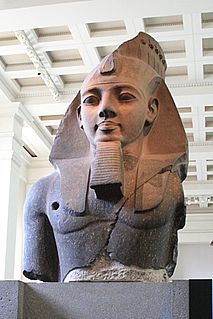
Ancient Egypt was a civilization of ancient Africa, concentrated along the lower reaches of the Nile River, situated in the place that is now the country Egypt. Ancient Egyptian civilization followed prehistoric Egypt and coalesced around 3100 BC with the political unification of Upper and Lower Egypt under Menes. The history of ancient Egypt occurred as a series of stable kingdoms, separated by periods of relative instability known as Intermediate Periods: the Old Kingdom of the Early Bronze Age, the Middle Kingdom of the Middle Bronze Age and the New Kingdom of the Late Bronze Age.

A sphinx is a mythical creature with the head of a human and the body of a lion with the wings of a falcon.

Khafre was an ancient Egyptian King (pharaoh) of the 4th Dynasty during the Old Kingdom. He was the son of Khufu and the successor of Djedefre. According to the ancient historian Manetho, Khafre was followed by king Bikheris, but according to archaeological evidence he was instead followed by king Menkaure. Khafre was the builder of the second largest pyramid of Giza. The view held by modern Egyptology at large continues to be that the Great Sphinx was built in approximately 2500 BC for Khafre. Not much is known about Khafre, except from the reports of Herodotus, writing 2,000 years after his life.

The ankh or key of life is an ancient Egyptian hieroglyphic symbol used in Egyptian art and writing to represent the word for "life" and, by extension, as a symbol of life itself.

Deir el-Bahari or Dayr al-Bahri is a complex of mortuary temples and tombs located on the west bank of the Nile, opposite the city of Luxor, Egypt. This is a part of the Theban Necropolis.

Ancient Egyptian art refers to art produced in ancient Egypt between the 6th millennium BC and the 4th century AD, spanning from Prehistoric Egypt until the Christianization of Roman Egypt. It includes paintings, sculptures, drawings on papyrus, faience, jewelry, ivories, architecture, and other art media. It is also very conservative: the art style changed very little over time. Much of the surviving art comes from tombs and monuments, giving more insight into the ancient Egyptian afterlife beliefs.

The Giza pyramid complex, also called the Giza necropolis, is the site on the Giza Plateau in Greater Cairo, Egypt that includes the Great Pyramid of Giza, the Pyramid of Khafre, and the Pyramid of Menkaure, along with their associated pyramid complexes and the Great Sphinx of Giza. All were built during the Fourth Dynasty of the Old Kingdom of Ancient Egypt, between 2600 and 2500 BC. The site also includes several cemeteries and the remains of a workers' village.

Spanning over two thousand years, ancient Egypt was not one stable civilization but in constant change and upheaval, commonly split into periods by historians. Likewise, ancient Egyptian architecture is not one style, but a set of styles differing over time but with some commonalities.

The block statue is a type of memorial statue that first emerged in the Middle Kingdom of Egypt. The block statue grew in popularity in the New Kingdom and the Third Intermediate Period, and by the Late Period, this type of statue was the most common. These statues were used in temples typically as funerary monuments of non-royal yet important individuals. According to primary sources from the New Kingdom, the posture of the statue was possibly intended to resemble a guardian seated in the gateway of a temple. In addition, their simple shape provided ample flat surfaces for inscriptions of offerings and invocations.

Nefaarud I or Nayfaurud I, better known with his hellenised name Nepherites I, was an ancient Egyptian pharaoh, the founder of the 29th Dynasty in 399 BC.

Naqada III is the last phase of the Naqada culture of ancient Egyptian prehistory, dating from approximately 3200 to 3000 BC. It is the period during which the process of state formation, which began in Naqada II, became highly visible, with named kings heading powerful polities. Naqada III is often referred to as Dynasty 0 or the Protodynastic Period to reflect the presence of kings at the head of influential states, although, in fact, the kings involved would not have been a part of a dynasty. In this period, those kings' names were inscribed in the form of serekhs on a variety of surfaces including pottery and tombs.

The Department of Ancient Egypt and Sudan is a department forming an historic part of the British Museum, with Its more than 100,000 pieces making it the largest and most comprehensive collection of Egyptian antiquities outside the Egyptian Museum in Cairo.

The Staatliches Museum Ägyptischer Kunst is an archaeological museum in Munich. It contains the Bavarian state collection of ancient Egyptian art and displays exhibits from both the predynastic and dynastic periods. The associated small Middle East section displays objects from the areas of Assyrian and Babylonian culture. For decades, the Egyptian museum was located in the Munich Residenz, but it was moved to the Kunstareal in June 2013.
The ancient Egyptian Incense burner: arm is a horizontal hieroglyph representing various types of horizontal tools used to offer, and burn incense. In tomb scenes it is often shown with an attached small box, or cup region, for holding incense, located on the upper surface; the offering individual is sometimes holding a grain-pellet of incense, with lines of incense, or connected grains-in-a-line equal to wafting smoke.
The ancient Egyptian Censer pot, is most commonly seen in Ancient Egyptian iconography as an offering, held in hand by the offering person or god. Many pots are offered in hands, or a single hand with offerings of oils, a liquid-(water), or other item in the pot.

The following outline is provided as an overview of a topical guide to ancient Egypt:

At least three ancient Egyptian granitic gneiss statues of Amun in the form of a ram protecting King Taharqa were displayed at the Temple of Amun at Kawa in Nubia. Construction of the stone temple was started in 683 BC by the pharaoh Taharqa. The ram is one of the animals sacred to Amun and several temples dedicated to Amun, including the one at Karnak, featured ram or ram-headed sphinx statues.

The Sphinx of Taharqo is a granite gneiss statue of a sphinx with the face of Taharqo. He was a Nubian king, who was one of the 25th Egyptian Dynasty rulers of the Kingdom of Kush. It is now in the British Museum in London.
This page list topics related to ancient Egypt.

The Department of Egyptian Antiquities of the Louvre is a department of the Louvre that is responsible for artifacts from the Nile civilizations which date from 4,000 BC to the 4th century. The collection, comprising over 50,000 pieces, is among the world's largest, overviews Egyptian life spanning Ancient Egypt, the Middle Kingdom, the New Kingdom, Coptic art, and the Roman, Ptolemaic, and Byzantine periods.






















